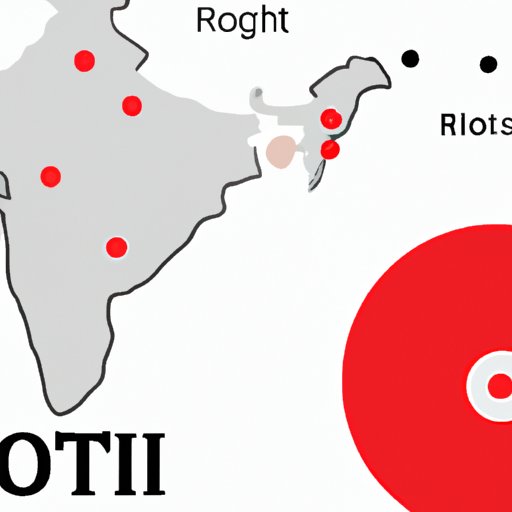Introduction
The red dot is a powerful symbol in Indian culture. For centuries, it has been used to represent various aspects of Hinduism and Indian traditions. This article will explore the origins and meanings of this iconic symbol, as well as its influence on gender roles and other forms of dress in India. By understanding the cultural significance of the red dot in India, we can gain insight into the importance of tradition and respect for religious beliefs.
Historical Overview of the Significance of the Red Dot in Indian Culture
The practice of wearing a red dot on the forehead is believed to have originated in ancient India. In Hinduism, the red dot is known as a “bindi” and is typically worn between the eyebrows. The bindi is said to be a representation of the third eye, which is associated with inner vision and wisdom. In some regions, the red dot was thought to ward off evil spirits and protect against bad luck.
Over time, the symbolic meaning of the red dot in Indian culture has evolved. In modern times, the bindi is often seen as a sign of marital status. Married women typically wear a red dot to signify that they are married, while unmarried women may opt for a black or white bindi instead. In some regions, the bindi is also used to indicate caste or social class. In addition, it is often worn during special occasions such as festivals and weddings.
In recent years, the bindi has become popular among younger generations as a fashion accessory. Many women choose to wear a bindi as part of their everyday outfit rather than just on special occasions. While the traditional meaning of the red dot remains, it has taken on new interpretations as it continues to evolve.

Exploring the Cultural Meanings and Significance of the Red Dot in India
The red dot has a variety of meanings in Indian culture. Let’s take a closer look at the different associations the bindi holds.
Significance in Hinduism
In Hinduism, the bindi is seen as a representation of the third eye, which is believed to be the gateway to enlightenment and spiritual power. According to Hindu mythology, the god Shiva wore a bindi to show his divine power. This symbol is still widely used in Hindu temples and ceremonies today.
Connection to Marriage and Womanhood
In many parts of India, the bindi is a sign of marriage. A married woman typically wears a red dot to signify her marital status. It is also seen as a sign of fertility and womanhood, as it is traditionally worn by brides and young girls.
“The bindi is a symbol of femininity and a way for women to express themselves,” says Dr. Shobhana Ramesh, an anthropologist at the University of Delhi. “It signifies beauty, grace, and strength, and is a reminder of a woman’s commitment to her family and society.”
Other Cultural Associations
In some parts of India, the bindi is also used to indicate caste or social class. In these regions, people from higher castes typically wear larger and more ornate bindis, while those from lower castes may opt for smaller and simpler designs. Additionally, the bindi is often used to show respect for religious figures or deities.

An Anthropological Look at the Red Dot in Indian Culture
To gain a better understanding of the red dot in Indian culture, let’s take an anthropological look at its role in rituals and ceremonies. In Hinduism, the bindi is often used to mark a person’s forehead during important ceremonies such as weddings and religious festivals. It is also widely used in spiritual practices such as yoga and meditation.
The bindi is also used to mark important milestones in a person’s life. For example, a baby’s forehead is sometimes marked with a bindi after birth to welcome them into the world. During puberty, young girls may be given a bindi as a sign of their transition into womanhood. The bindi is also used to mark the passing of a loved one.
By examining the cultural implications of the red dot, we can begin to understand its deeper meaning in Indian culture. It is a powerful symbol of spirituality, femininity, and beauty.

The Meaning of the Red Dot: How It Represents Different Aspects of Indian Culture
The bindi is a multifaceted symbol that represents different aspects of Indian culture. Let’s take a closer look at some of these meanings.
Symbol of Spiritual Power
As mentioned earlier, the bindi is seen as a representation of the third eye, which is believed to be the gateway to enlightenment and spiritual power. In Hinduism, the bindi is used to mark important milestones in a person’s life and is often worn during religious ceremonies and rituals.
Representation of Femininity, Beauty, and Status
The bindi is also seen as a symbol of femininity, beauty, and status. In many parts of India, married women wear a red dot to signify their marital status, while unmarried women may opt for a black or white bindi instead. It is also used to indicate caste or social class. In some regions, people from higher castes typically wear larger and more ornate bindis, while those from lower castes may opt for smaller and simpler designs.
Examining the Social Significance of the Red Dot in India
The bindi has a significant impact on gender roles and other forms of dress in India. In some parts of the country, wearing a bindi is seen as a sign of respect for religious figures or deities. Additionally, it is believed to ward off evil spirits and protect against bad luck.
The bindi is also seen as a sign of marital status. Married women typically wear a red dot to signify that they are married, while unmarried women may opt for a black or white bindi instead. This practice reinforces traditional gender roles and expectations of women in Indian culture.
Finally, the bindi has become popular among younger generations as a fashion accessory. Many women choose to wear a bindi as part of their everyday outfit rather than just on special occasions. While the traditional meaning of the red dot remains, it has taken on new interpretations as it continues to evolve.
Conclusion
The red dot is a powerful symbol in Indian culture. Its origins date back centuries and it has many different meanings and associations. In Hinduism, it is seen as a representation of the third eye and is believed to bring spiritual power and enlightenment. It is also a sign of marital status and is often used to indicate caste or social class. Finally, it has become popular among younger generations as a fashion accessory.
By exploring the cultural significance of the red dot in India, we can gain insight into the importance of tradition and respect for religious beliefs. It is a symbol of femininity, beauty, and status, and its influence on gender roles and other forms of dress should not be underestimated.
(Note: Is this article not meeting your expectations? Do you have knowledge or insights to share? Unlock new opportunities and expand your reach by joining our authors team. Click Registration to join us and share your expertise with our readers.)
